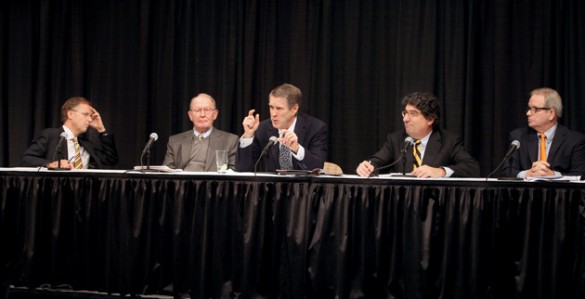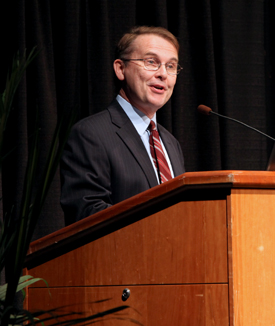For the last half-century, American research universities have been the best in the world and the source of a steady stream of innovations that have contributed to the nation’s economic growth and transformed modern life.
In the last decade, however, this unique partnership between academia and government has been threatened by tough economic times and the perception that the United States has been living beyond its means.
On Jan. 16, a group of stakeholders from academia, federal and state government and the private sector—including Tennessee Gov. Bill Haslam, Sen. Lamar Alexander, former Senate Majority Leader William Frist, Vanderbilt Chancellor Nicholas S. Zeppos, University of Tennessee Executive Vice President David Millhorn and Chad Holliday, chairman of the board of Bank of America and retired chairman of DuPont—attended a workshop at Vanderbilt to discuss the steps that must be taken to ensure the future of this critical partnership.

The meeting was a follow-up on the report “Research Universities and the Future of America: Ten Breakthrough Actions Vital to Our Nation’s Prosperity and Security,” issued by the National Research Council in June. The report was requested by a bipartisan group in Congress in 2005.
Wednesday’s workshop had two parts. The morning was open to the media and consisted of three expert panels that discussed the report and its contents. In the closed afternoon session, a select group of attendees drafted a list of specific steps that they think need to be taken and sent them to officials at the National Academies in Washington, D.C.
“There’s a lot of octane in this room,” said Zeppos, as he scanned the 125 attendees during his introductory remarks.
While acknowledging the serious problems that the university research enterprise faces, Zeppos said, “There are incredible opportunities. [rquote]I’m an optimist because every day I see the positive impact that education, research and discovery can play.[/rquote] I’m eager to build better partnerships across the board” so that “we can work together in a new, dynamic way to create the 21st century.”
The report “got it right,” said Haslam. “Innovation is the signature of our country, and we should be intentionally maximizing our assets.” Haslam reported that, although Tennessee gets $2.5 billion in federal research and development funds—the eighth highest in the nation—Tennessee businesses qualify for only 0.7 percent of federal small business innovation awards. His administration has taken a number of measures to encourage entrepreneurship, and the number of new startups increased by 11 percent and patent applications increased by more than 50 percent in the last year.
“We need to become outcome-focused instead of input-based,” the governor said.
According to Alexander, one of the reasons that America can produce 25 percent of the world’s wealth every year with only 5 percent of the world’s people is because the nation leads the world in innovation. Alexander said it has been very depressing to watch what he calls the “big squeeze” each year as the annual 3-4 percent growth in Medicare and Medicaid funding has squeezed out spending for research and education.
Frist seconded Alexander’s view, adding that if we stay on the current course for another 12 years there will be no money left to invest in research and education—or anything else.
“The only way we can get out of this trap is to grow the economic pie, and innovation is the best way to do so,” Frist said. Ironically, U.S. support for research and development has been steadily declining at the same time that our economic competitors China and Europe are increasing their support.
“Our emphasis on ‘we need something now’ gets in the way of growing the pie,” Frist said.
Despite their efforts, other countries are having difficulty in copying the U.S. model, reported Holliday, who chaired the committee that wrote the NRC report.
“It’s in our DNA. The research university system itself is a unique American innovation,” he said. If other countries keep at it, they will ultimately be able to match us. “But, by then, I hope we will be at an entirely new level.”
Holliday advocated a change in tax laws that would reward companies for making long-term investments in university research. But Alexander cautioned against this approach because it would be caught in current congressional efforts to simplify the tax code.

“Engineers are responsible for more revolutions than any other group,” said Philippe Fauchet, dean of Vanderbilt’s School of Engineering, who moderated one of the panels. He backed his statement up by laying claim to a number of historic revolutions beginning with the invention of the wheel, jumping to the invention of the steam engine that began the industrial revolution, then to mass electrification, the telephone, the first affordable car, the first transistor and the moon landing. More recent revolutions include the Internet, the first MRI scanner, the smartphone and composite materials that have begun to replace metals in the construction of airplanes and automobiles, he said.
In the past there have been two types of engineers, Fauchet said: those who worked on blue-sky projects that didn’t have any obvious application, and those who worked on industrial problems. What we need now to keep the revolutions coming is a new type of engineer who works on solutions to major societal problems, he proposed.
UT’s Millhorn provided a different kind of historic perspective. He showed a graph of federal research and development funding over the last century that showed federal support for universities beginning after the end of World War II. It remained at moderate levels until the 1960s following the launch of Sputnik. During this period, the lion’s share of federal dollars supported space-related research, but this dropped precipitously after the end of Apollo. Federal funding began rising again when President Nixon launched the war on cancer in 1971. Since then, the proportion of R&D funding supporting health-related research has continued to grow. Today it accounts for more than 50 percent.
In dollar terms, federal spending has increased over this period to a current level of about $140 billion per year. But it has dropped substantially as a percentage of the total federal budget and the gross domestic product. In the 1960s, it was 10-12 percent of the federal budget but has dropped to 4 percent. As a percent of GDP, it has dropped to 1 percent from a high of 1.4 percent.
Millhorn also shared data on the history of federal and private industry spending on research and development. This data showed that in the 1950s, the government was spending substantially more money on R&D than industry. Since then, however, industry support has outstripped government support and is now three to four times greater.
“This makes it clear that universities have to change. They need to spend more time and effort to understand industry goals and what industry needs and wants,” he said.
Millhorn provided an example of a university-government-industry partnership that represents the kind of “innovation ecosystem” that he and Holliday both think will be needed in the future. It is a biofuel pilot plant that was built by a partnership among UT, Oak Ridge National Laboratory and DuPont to convert a nonagricultural crop, switchgrass, to ethanol. “We have shown that we can produce ethanol at a competitive price,” he said.
The partnership also has established a biomass plant to produce carbon fiber from switchgrass. “Soon we won’t just produce the fuel we need to operate our vehicles from plants, but also the material that our vehicles are built from,” Millhorn predicted.